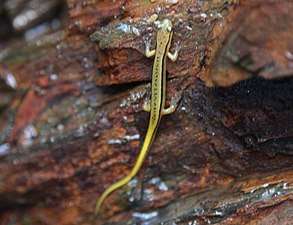Inez Whipple Wilder
Inez Whipple Wilder (May 19, 1871 – April 29, 1929), born Inez Luanne Whipple, was an American herpetologist and anatomist, affiliated with Smith College from 1902 until her death. She made notable contributions to the study of fingerprints and the biology of salamanders.
Inez Whipple Wilder | |
|---|---|
| Born | Inez Luanne Whipple May 19, 1871 |
| Died | April 29, 1929 (aged 57) |
| Alma mater |
|
| Spouse(s) | |
| Scientific career | |
| Fields | Herpetology, Comparative anatomy |
| Institutions | Smith College |
Early life and education
Wilder was born on May 19, 1871 at Diamond Hill, Cumberland, Rhode Island, the third and youngest child of parents Eliab Daniel and Sarah Whipple (née Wheaton).[1][2] She graduated from Rhode Island Normal School (now Rhode Island College) in 1890, and earned a Ph.B. at Brown University in 1900. She then taught at Rhode Island Normal School and Northampton High School until joining the faculty of Smith College in 1902 as instructor of zoology. She earned her M.A. from Smith College in 1904, and became associate professor in 1914 and full professor in 1922.[3][4]
Career
In 1904 Inez published an influential study on the skin of mammalian palms and feet, describing how embryonic pads influence later ridges and patterns, now known as an important early contribution to dermatoglyphics, the study of fingerprints.[5][6] Her paper, entitled "The Ventral Surface of the Mammalian Chiridium: With Special Reference to the Conditions Found in Man",[7] summarized all prior knowledge of the field of genetics and dermatoglyphics, and was the most significant study of ridges in non-human animals of its time.[5][8] At the time she was a research assistant of Harris Hawthorne Wilder, and on July 26, 1906 the two were married in Boston.[9] Harris Wilder published widely on anatomy, genetics, and anthropology, and the two were known as the most prominent American researchers of fingerprint morphology of the early 20th century.[8][10] Inez' 1914 book Laboratory Studies in Mammalian Anatomy was widely used, and a second edition was published in 1923.[11]
The Wilders also assembled what was at the time the most active research program in salamander biology in the world, later joined by Emmett R. Dunn.[3] While Harris and Inez both studied salamanders, they worked independently and never published together. Inez was the first to name and describe the function of nasolabial grooves, olfactory structures found plethodontid salamanders (also known as lungless salamanders). Later, with Dunn she proposed an explanation for the evolutionary loss of lungs in plethodontids (a trait which her husband had discovered).[3] She studied the salamanders Desmognathus fuscus and Eurycea bislineata in depth, and published in total 13 papers on salamander biology. In 1925 she published The Morphology of Amphibian Metamorphosis, a book in which she describes the comparative biology of D. fuscus, E. bislineata, and the newt Notophthalmus viridescens.[3]
Later life
Her husband died in February, 1928, after which she became chair of the Smith College Department of Zoology. After a long illness, Inez Wilder died at Northampton on April 29, 1929, aged 57.[3] Shortly before her death she completed editing her husband's autobiography.[12] Wilder House, a residential house at Smith College, was named in honor of her and her husband in 1930.[13]
Eponym
She is also commemorated in the name of the Blue Ridge two-lined salamander, Eurycea wilderae.[14]
_-_11426080585.jpg) Eurycea wilderae
Eurycea wilderae.jpg) Eurycea wilderae
Eurycea wilderae Eurycea wilderae
Eurycea wilderae
Books
- Laboratory Studies in Mammalian Anatomy[15], P. Blakiston's Son & Co., 1914
- The Morphology of Amphibian Metamorphosis, Smith College, 1925
- Editor: The Early Years of a Zoölogist: The Story of a New England Boyhood, Smith College, 1930
References
- Who's Who in New England. A.N. Marquis. 1909. p. 1015.
- Ballou, Adin (1888). An Elaborate History and Genealogy of the Ballous in America. Providence, RI: Ariel Ballou & Latimer W. Ballou. pp. 816–817.
- Adler, Kraig (2007). "Wilder, Harris H. (1864–1928); Wilder, Inez W. (1871–1929)". Contributions to the History of Herpetology. 2. Society for the Study of Amphibians and Reptiles. pp. 118–120. ISBN 978-0916984717.
- Ogilvie, Marilyn Bailey; Harvey, Joy, eds. (2000). "Wilder, Inez (Whipple) (1871–1929)". The Biographical Dictionary of Women in Science: L-Z. Taylor & Francis. p. 1378. ISBN 978-0-415-92040-7.
- Ashbaugh, David R. (1999). Quantitative-Qualitative Friction Ridge Analysis: An Introduction to Basic and Advanced Ridgeology. CRC Press. pp. 43–49. ISBN 978-1-4200-4881-0.
- Houck, Max M. (2016). Forensic Fingerprints. Elsevier Science. pp. 63–64. ISBN 978-0-12-800672-6.
- Whipple, Inez L. (1904). "The Ventral Surface of the Mammalian Chiridium with special reference to the conditions found in man". Zeitschrift für Morphologie und Anthropologie. 7 (2): 261–368. JSTOR 25745588.
- Cole, Simon A. (2009). Suspect Identities: A History of Fingerprinting and Criminal Identification. Harvard University Press. pp. 108–109. ISBN 978-0-674-02968-2.
- "The Smith College Monthly". 14. Smith College. 1906: 65. Cite journal requires
|journal=(help) - Plato, Chris C.; Garruto, Ralph M. (1990). "Historical Notes on Dermatoglyphics: From Purkinje to Cummins". In Durham, Norris M.; Plato, Chris C. (eds.). Trends in Dermatoglyphic Research. Kluwer Academic. pp. 2–9. ISBN 978-94-009-2137-5.
- "Reviewed Work: Laboratory Studies in Mammalian Anatomy. Second revised edition by Inez Whipple Wilder". The Journal of Education. 99 (5): 136. 1924. JSTOR 42749539.
- "In Memoriam". The Phi Beta Kappa Key. 7 (6): 426. 193o. JSTOR 42914233.
- Annual Register of the Alumnae Association of Smith College. Smith College Alumnae Association. 1930. p. 32.
- Dodd, C. Kenneth (2004). The Amphibians of Great Smoky Mountains National Park. University of Tennessee Press. p. 161. ISBN 978-1-57233-275-1.
- Wilder, Inez Whipple. Laboratory studies in mammalian anatomy, by Inez Whipple Wilder (2d rev. ed.). Philadelphia: P. Blakiston's son & co.
External links
- Works by or about Inez Whipple Wilder at Internet Archive
- Works by Inez Whipple Wilder at HathiTrust
- Inez Whipple Wilder Papers at the Smith College Archives, Smith College Special Collections
- Inez Whipple Wilder at Find a Grave